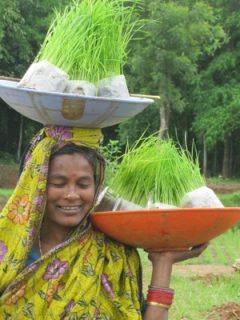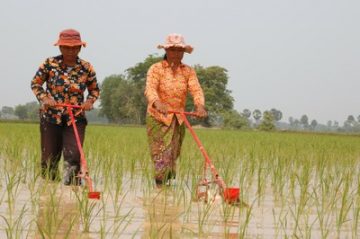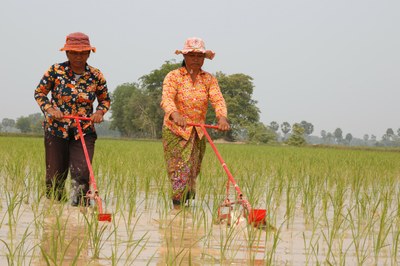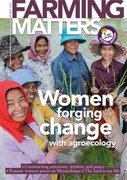It is said that ‘rice is grown on women’s backs’. Globally, around a billion people cultivate rice, of which 50 to 90 percent are women. With conventional practices, they perform backbreaking tasks like seedling removal, transplanting and weeding in bent posture and under wet conditions for more than 1000 hours per hectare. In addition, they are exposed to chemicals. But the System of Rice Intensification (SRI) enables farmers to work under healthier conditions while creating various other physical and social benefits. The consequences are significant, as we learn from women in India, Malaysia and Cambodia.

Bodies matter – India
Women from small and marginal farming families doing SRI have been making the news in India for their adoption of a new approach that challenges the age-old beliefs and practices of rice farming. However, rarely one comes across mention of the impact of SRI on their wellbeing and their bodies.
While doing research in Odisha, India during 2011- 2012 women from 20 villages narrated their positive experiences with SRI. They reported a reduction in drudgery and pain, fewer infections in their hands and legs, and having more time to cook and eat properly, rest or to do other work. Major reasons for these changes were a reduction in hours and amount of work, change in their working environment, more upright posture due to use of a weeder, and men’s participation in tasks like weeding. More specific information was gathered in three villages namely Rajnapalli of Ganjam district, Gunjigaon of Kandhamal district and Kokariguda of Koraput district. Women shared the drudgery and pain experiences explicitly during the participatory exercises of a Rapid Comparative Pain Assessment (RaCoPA) entailing group discussions, interviews and informal interactions.Groups of women ricefield workers discussed the tasks they perform under different rice-growing methods. They talked about which task hurts how much and showed this on a large drawing of a woman. At the end, a comparative picture was generated to see differences in physical experiences of drudgery and pain. Interestingly, they all mentioned that these aspects never emerged in earlier discussions.
RaCoPA exercises revealed that with SRI practices, there is significant reduction in drudgery and pain in back, legs and hands. With SRI practices women spend less time in stressful postures carrying out repetitive movements and they handle lighter materials compared to standard cultivation practices (see box).
With SRI, women spend less time in stressful postures carrying out repetive movements
SRI fundamentally changes the conditions under which women have to work. Conventionally, women working in bent or sitting postures in flooded fields for long hours, come into contact with various disease causing vectors exposing them to multiple health risks like intestinal to skin diseases and female urinary and genital ailments. This affects their ability to work and earn money, and furthermore drains out their money on health care, sometimes making them indebted, as found in research by Vent and others in 2015. With SRI practices, rice fields are no longer kept continuously flooded, thus reducing women’s prolonged exposure to these water-borne disease vectors. Furthermore where organic SRI is being practiced, women do not face problems from chemical fertilizers and pesticides.
As women are the producers of our food, we cannot afford to ignore their wellbeing. When they thrive, our agriculture thrives and vice versa. The eco-logic of SRI has a body and gender-logic too which needs to be paid attention to and invested in if we are seriously concerned about our toiling women.
Creativity and solidarity – Malaysia
The System of Rice Intensification (SRI)
SRI is an agroecology-based method for growing rice that enables farmers to achieve higher yields with less water, seed, and agrochemicals, and generally less labour (see Farming Matters, 29.1, 2013). Its major practices include planting of younger seedlings at wider spacing, frequent weeding, preferably mechanically, maintaining a non-flooded, moist field condition and managing soil health organically. This innovative system of rice cultivation achieves an average of 20- 50% higher yields than standard cultivation practices. This increase in production fosters food security, improves nutrition and boosts incomes. Thousands of farmers around the world are now using principles of SRI also with other crops such as wheat, maize, millet, sorghum, vegetables and tubers. With SRI gaining popularity around the world, benefits for women are becoming more noticeable.
Modern agricultural modes of production do not encourage farmers to be inquisitive and exacerbate the power imbalances in our food systems. On the contrary, agroecological practices like SRI promote farmers’ creativity as it encourages them to move away from linear thinking and start viewing their farms as ecosystems that require thoughtful management. A paddy field is no longer a factory that produces rice, but an ecosystem that houses microbes, insects, birds, flowers, trees, and farmers. In most cases of SRI, farmers experiment with the general principles of SRI and make their own judgments and adaptations, rather than just follow instructions. With agroecology, being creative is as much a means as it is an outcome, and most farmers feel compelled to constantly invent and reinvent. SRI is a practice that allows farmers to use their creativity and be resourceful.
Salwati Mohd. Ariffin, a Kelantanese paddy farmer, left her desk job five years ago to take up farming as a profession. As a mother to five daughters, she is determined to rid the land of unnecessary chemicals because she wants to leave her children with a cleaner and safer environment to grow up in. She also wishes to free smallholders like herself from having to purchase and use expensive inputs as they are “polluting and degrading the rural landscape that has such beauty and bounty when managed with respect for nature”.Once Salwati gained knowledge of SRI, she began producing organic rice on her own. She prepared the land and set up her nursery, then developed an outdoor composting workshop right next to her plots. Eight cropping seasons later, she is making impressive gains, and her yields are now estimated at 10 metric tons per hectare by researchers from UPM (Universiti Putra Malaysia). The increase in yield isn’t the most important outcome for her; it’s the long-term investment in sustainable rice production that she is committed to. She realises this is a paradigm shift and is working to instill confidence and pride in paddy farmers around her by helping them to understand the principles of SRI and to apply them in accordance to their social, cultural and environmental circumstances.

In 2014, Salwati, in cooperation with SRI-Mas, the Malaysian Agroecology Society for Sustainable Resource Intensification, facilitated the establishment of Kumpulan Organik Kelantan (Organic Group of Kelantan ). Maintaining a horizontal structure, K.O.K members stay in touch with eachother through WhatsApp by sharing best practices and exchanging questions and answers. This revives a sense of solidarity among farmers.
To overcome the occasional shortage of human power, farmers can also ask for help by using WhatsApp, reinforcing the local tradition of gotong-royong. For example, at harvest time, Salwati and her network of farmers gather to help each other, and they study the yield components together, to see where further improvements could be made. With the help of academics, farmers who practice SRI gain better insight into their farming practices and outcomes, which in turn allows them to sell their products with more confidence.
Changing gender roles – Cambodia
SRI practices that reduce labour and drudgery for women
Planting of single seedlings at wider spacing. This implies fewer seeds, which requires less work, less manure and ultimately reduction of the total workload.
Careful removal of younger seedlings from the nursery and planting them as quickly as possible to avoid transplanting shock. This implies that the nursery should be made in a place inside or near to the main field, which reduces the walking distance.
Transplanting fewer seedlings in total. This means workers do not have to remain inside the mud or water in bent posture for longer hours.
Use of the weeder. This enables women to move from a permanently bent position to an upright position. Hours spent on supplementary manual weeding are reduced.
Under the hot midday sun in the middle of a rice paddy, 57-year old farmer Tea Sarim was enlightening ten other women farmers from her village of Deim Pour in Champey community, in Kampot province. Holding a bunch of rice seedlings in one hand and lifting a single seedling with the other, Sarim began a question-and-answer session on the issues and concerns in the agricultural sector that these farmers currently face. The smiles on the women farmers’ faces expressed their interest in learning SRI techniques, having heard about how these can raise yields while also lightening their workloads.
Sarim was selected to participate in the Center Farmer for Participatory Action Research (CFPR) as part of a regional project covering four countries in the Lower Mekong River region. She became a farmer trainer, locally called a Krou Kasekor, to share knowledge of SRI with other farmers with her community.
With the conventional farming practices, Sarim could only produce enough to feed herself, her four children, and her parents for ten months of the year. There was nothing left to sell. Within three years of practicing SRI, she has been able to produce enough to feed her family all year around and still have some extra rice to sell. Sarim estimates that SRI helps her to reduce her workload by about 20% during the farming season: “With conventional farming, we have to spend a lot of time and energy, but with SRI farming, we use our brain.”
Sarim has become a popular SRI trainer in her village. She helps women farmers in neighbouring villages move from poverty to prosperity. She enjoys sharing the new knowledge and skills that she has gained from her three-year experience with SRI. Most of the women whom she has coached on SRI farming techniques face many problems, such as domestic violence. Sarim observes, “Women are easily blamed by their husbands for the problems of the family.” But with SRI, women’s positions are improving, Sarim has noted. They are not treated the same as before because now they are being recognised as ‘smart’ and have become leaders.
The key for this change is that women are quick learners. They absorb the SRI ideas faster than men because they pay careful attention and easily grasp the concepts, Sarim finds. Men do not always want to learn because they prefer continue farming the same way that their parents taught them; “they think that they already know how to farm.” But, even though men sometimes find it hard to come and listen to women’s stories, “a woman has the power to lead her husband into practicing SRI” says Sarim, laughing.
In the past, there was a saying, ‘Women cannot turn the kitchen around.’ Sarim, however, tells the women farmers: “I am different because I have made myself different. I can turn the kitchen around, and I want other women to succeed too.”
Sabarmatee Tiki , LIM Liang Chun and Oeurm Savann
Sabarmatee Tiki (sabarmatee@gmail.com) works with Sambhav, a grassroots-level NGO focusing on environmental and gender issues in Odisha, India, and is pursuing her PhD at Wageningen University, The Netherlands.
LIM Liang Chun (liangchun.lim@sciencespo.fr) works with the Malaysian Agroecology Society for Sustainable Resource Intensification (SRI-Mas) and is currently a Masters student of International Development at Sciences Po Paris.
Oeurm Savann (soeurm@OxfamAmerica.org) is the Regional communication officer for Oxfam United States in Cambodia.
Sabarmatee would like to thank Olivia Vent and Dr. Norman Uphoff for their encouragement and feedback on this article, and Wageningen University and NWO-WOTRO, Netherlands for supporting her research,


